Mango Kalakand is a delectable Indian dessert (mithai) made from whole milk and fresh mango puree. This lightly sweetened dessert is an indulging way to devour the sweetness of fresh mangoes.
Crafted from scratch, this effortless one-pan Mango Kalakand is the pure essence of juicy ripe summer mangoes.
Experiment with plant-based cooking using exotic fruits and vegetables to create sustainable dishes.
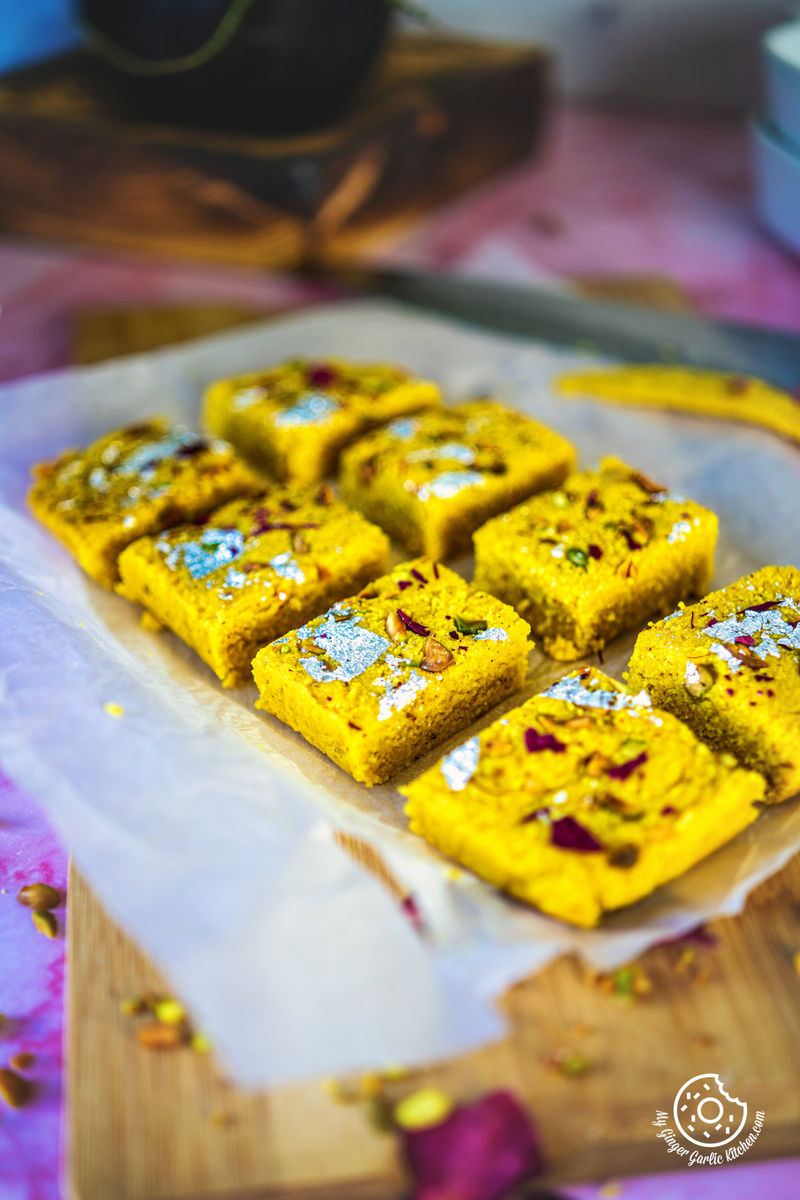
Table of contents
It is a vegetarian, gluten-free, and egg-free dessert. Plus, it takes only 45 minutes.
In this article, I present a step-by-step picture and video recipe on how to make Mango Kalakand from scratch, assuring your dessert table shines with culinary sophistication and exquisiteness.
About Mango Kalakand
Mango Kalakand or Aam Ka Kalakand is a fusion of traditional Indian dessert flavors with a reviving twist of mango and the luxurious touch of saffron and cardamom. This gluten-free and vegetarian sweet dish gladdens both the palate and the visual senses.
With its creamy milky taste, crumbly and soft texture, aromatic flavors, and tropical sweetness, it’s a perfect delight for festivals, celebrations, other occasions, or for just a simple dessert craving.
It is a popular Indian mithai (sweet dish) which is made using mangoes, milk, sweetener and flavorings. This classic sweet dish mingles the richness of full-cream milk, the succulence of mangoes, the sweetness and creaminess of condensed milk, all within a single pan.
The amalgamation of curdled milk, mangoes, and sweetened condensed milk creates an extraordinary, sweet dish that has a crumbly yet melt-in-mouth texture and a sweet taste with a slight tang of mango.
Gently scented with a hint of cardamom and saffron, this dish is a pure delight for eyes and your sense of taste.
In this simple recipe, the milk undergoes curdling process, and then the curdled milk seamlessly melds with luscious mango puree, receiving a delicate touch of cardamom aroma.

Mango, also known as “King of Fruits,” has a special place in Indian cuisine, especially when it comes to making desserts and drinks.
In India there is an abundance of mangoes during summer months, and other than eating mangoes as a fruit or devouring mango milkshake, people love to use them in desserts and other dishes.
Some of the popular varieties of mango dishes are mango peda, mango kulfi, mango halwa, mango sago, mango falooda, mango lassi, mango shrikhand, mango mastani, and mango kalakand.
Kalakand, is a beloved Indian mithai that is made with milk. Making traditional kalakand involves simmering curdled milk (chena) alongside condensed milk.
It is a traditional milk-centric mithai where the milk is curdled to yield fresh chena, and this chena is cooked with sugar and additional milk until a dense, paste-like consistency is achieved. Then this mixture gets set in a pan, and later sliced into squares.
Mango Kalakand is a modern and sumptuous twist on classic kalakand which stands out for its gorgeous bright color, irresistible taste and exquisite appeal. Here, the curdled milk is cooked with mango puree, sweetened condensed milk until it becomes thick and forms a non-sticky ball. Then this mixture is transferred into a pan to set. Once set, it is cut into desired shapes.
With this easy recipe, you can now make the fail-proof mango kalakand recipe that is bursting with mango goodness. If you have a fondness for mangoes, this dessert is an experience not to be missed.
This Mango Kalakand
✔︎ is a tropical delight
✔︎ awakens your senses with delightful aroma
✔︎ melts in your mouth
✔︎ is a staple during festivals and celebrations
✔︎ is a treat made from scratch
✔︎ can be prepared with different types of mangoes
✔︎ is vegetarian and gluten free
✔︎ can also be customized
✔︎ is a feast for the eyes and tongue

Ingredients
Full-Cream (Whole) Milk
It forms the base of Mango Kalakand. So, to make this kalakand you will need full-fat or whole milk. The fat from the milk gives the richness and the creamy texture of this sweet dish.
White Vinegar
It is needed to curdle the milk. To separate the milk into curds and whey, you will need to add about 2-3 tablespoons of vinegar to the boiling milk. This process results in the formation of curdled milk (chena), which is the backbone of thick and rich Kalakand.
Mango Puree or Mango Pulp
Mango is the star ingredient of this dessert as it infuses irresistibly with curdled milk to give dessert a mango flavor. It also brings natural sweetness and a gorgeous yellow hue to the Kalakand.
For making kalakand I used fresh mango puree, but you also use store-bought puree or pulp.
Cardamom Powder
It is added to give an aromatic Indian mithai touch to this dessert. The warm and inviting fragrance of cardamom harmonizes the mango flavors. However, adding cardamom powder is Optional in this recipe.
Saffron milk
Saffron strands are added for a luxurious and subtle golden hue, distinct aroma, and a delicate flavor. To make saffron milk, I have soaked about 10 crushed saffron strands in warm milk for about 10 minutes. Adding saffron milk is optional in this recipe.
Sweetened Condensed Milk
To sweeten this dessert, I have used homemade sweetened condensed milk, but you can also use store-bought condensed milk. It works equally fine. It adds a creamy touch and sweetness to kalakand. I have added about 1 cup of sweetened condensed milk here, but feel free to adjust the amount based on your preference for sweetness.
Garnish (Optional)
I have garnished kalakand with chopped pistachios for crunch and nutty flavor, saffron for luxurious floral essence, and crushed dried rose petals for a touch of elegance. All these garnishes add both visual appeal and a lovely texture, and delightful taste.
I have also garnished the kalakand edible silver for a shimmering finish and elegance to make it suitable for festive occasions.

Variations
-
Chocolate Kalakand: To create this unconventional fusion, swap mango puree with 1/4 cup of cocoa powder or chopped dark chocolate. This blend of chocolate and milk offers a distinct and indulgent twist on the traditional recipe.
-
Coconut Mango Kalakand: If you are a fan of coconut and mango desserts such as Coconut Mango Chia Pudding, or Coconut Mango Panna Cotta, then you can make coconut mango kalakand. To combine the tropical flavors of mango and coconut, add about 1/2 cup of desiccated coconut into the pan while boiling the curdled milk with mango puree. The rest of the recipe will be the same.
-
Nutty Kalakand: Love the crunch in your burfis and fudge? Then you can try adding some chopped almonds, cashews, and pistachios to the kalakand mixture. They supply richness and delightful texture to creamy Kalakand.
-
Dried Fruit Kalakand: Love dried fruits in your desserts? Then you can elevate the flavor profile of kalakand by adding dried fruits like raisins, chopped dates, dried cherries, or dried apricots. They add chewy texture, natural sweetness, and surprise with every bite.
-
Rose Kalakand: Rose infused Indian sweets are a delight. This floral touch of rose pairs beautifully and sophisticatedly well. To make this elegant version, infuse the mixture with a few drops of rose water or rose essence.
-
Spicy Kalakand: Sweet spices taste really well in Indian desserts. You can add a dash of cardamom, a pinch of nutmeg and a tiny bit of ground cinnamon for the subtle warmth of sweet-smelling spices into the kalakand.
Serving Suggestions
Mango Kalakand can be served chilled for a refreshing and cooling dessert option after a hearty Indian meal. The dishes that go well with mango kalakand are Paneer Korma , Mango Raita, Vegetable Jalfrezi, Restaurant Style Garlic Naan - 3 Ways, and Khichdi Paratha. You can also add it to your festive dessert table.
For an artistic touch and aesthetic presentation, you can drizzle a swirl of mango puree on the serving plate, right before placing the Kalakand pieces.
If you want to create an indulging fusion of flavors and textures, then serve it as a layer in your trifle desserts or parfaits.

Storage Suggestions
Mango Kalakand stays fresh for about 4-5 days when stored in an airtight container in the refrigerator. After that, the texture and taste will start to change.
Freezing Option
If you have leftover mango kalakand, or just want to increase the shelf life, then you can consider freezing this dessert. To freeze, wrap individual pieces in plastic wrap and then place them in a freezer-safe container.
When you want to serve, thaw them in the refrigerator for 4-5 hours before consumption.
Tips and Tricks for Perfect Mango Kalakand
-
High Quality Ingredients: Always use superior quality ingredients, such as ripe and juicy mangoes, and fresh milk. The freshness and good quality of ingredients remarkably affects the final outcome of kalakand.
-
Consistent Stirring: Simmering on medium heat, stirring constantly is recommended to prevent it from sticking to the bottom of the pan.
-
Sweetness: The amount of sweetness depends on the taste of the mango puree and your taste preference. Feel free to adjust the amount of sweetened condensed milk accordingly. So, if your mangoes are sweet then you can reduce the amount of sweetened condensed milk.
-
Patience: When cooking curdled milk, you need to have some patience. The slow reduction process ensures the soft, rich and creamy base of kalakand.
-
Saffron Soaking: For a lovely color and profound saffron flavor, it is recommended to soak crushed saffron strands in warm milk for at least 10 minutes before adding to the mixture.
-
Mango puree: Using fresh mango puree or pulp ensures the best taste and texture. But if you are making it in the off season then you can make the same recipe with store-bought mango puree.
-
Set and Cool: If you are planning to set kalakand in the refrigerator, then let the Kalakand sit at room temperature for a while before refrigerating. This moderate cooling helps in keeping the texture.
-
Garnishing: I have garnished the kalakand with edible silver leaves, chopped pistachios, saffron strands and dried rose petals. You can use any garnish to enhance the dessert’s visual appeal.
-
Strain: If you are using fibrous mangoes for making puree, then make sure to strain the puree before adding to the curdled milk. This step is necessary to reach a silky texture in the final dish.
-
Grease/line the Pan: Grease the tray with a thin layer of ghee or line it with parchment paper before transferring the Kalakand mixture. This step prevents it from sticking and helps in easy removal.
-
Slicing: When slicing the Kalakand, make sure to use a sharp knife to get the clean cuts.

FAQ
Can I use low-fat milk to make Kalakand?
No, I would not recommend using low-fat milk. Since it is a milk-based dessert, using full-cream (whole) milk is recommended to get the rich and creamy kalakand.
How do I ensure the Kalakand sets properly?
Make sure that you let the Kalakand sit at room temperature for at least 3 hours or until firm before slicing. This slow cooling helps in getting the desired texture. Once set, you can cut them in any shape you like.
Can I add other fruits to Mango Kalakand?
Mango is the main ingredient of this kalakand recipe. But if you want to experiment with the flavors then you try making this dessert with other fruit flavors such as strawberry, blueberry, or pineapple.
How do I prevent the Kalakand from becoming too dry?
To avoid dryness, make certain that you don’t overcook the kalakand mixture. Check the doneness and remove it from the heat as soon as it reaches the setting stage and forms a non-sticky ball.
Can I reheat Mango Kalakand?
Mango Kalakand tastes best when served chilled, so it is not recommended to enjoy Mango Kalakand warm.
Can I use canned mango pulp instead of fresh mangoes?
Yes, you can absolutely use canned mango pulp or puree as an alternative. Just remember to use a good quality puree that does not have any additives or preservatives.
How can I adjust the sweetness of the dessert?
You can surely adjust the sweeteners of this sweet dish. Simply taste the mango puree before adding it to the mixture and adjust the amount of sweetened condensed milk accordingly to attain your desired level of sweetness.
Can I freeze Mango Kalakand?
Yes, freezing mango kalakand is possible. To freeze, wrap the pieces in a plastic wrap and then place in a zip lock bag or a freezer safe airtight container and freeze for up to 2 months. When you want to eat, thaw them in the refrigerator before consuming.
Can I make Mango Kalakand gluten-free?
Mango Kalakand does not contain any grain, so it is naturally gluten-free.
Mango Kalakand (Step-by-step photo instructions)
For making Mango Kalakand
- In a thick-bottomed pan, pour 2 liters of full-cream milk over medium heat. Allow it to come to a boil while stirring constantly to prevent sticking. This should take around 10 minutes. Once the milk is boiling, add23 tablespoons of white vinegar and stir thoroughly. You'll notice the milk curdling, and it will separate into curds and whey. If the curdling is insufficient, even after adding vinegar, it indicates that more vinegar is needed. In such a case, add another tablespoon of vinegar.
- Increase the heat to medium-high and continue boiling the mixture until it reduces by half, stirring occasionally. After this, incorporate the mango puree and stir again to combine. Add 2 tablespoons of saffron-soaked milk and sweetened condensed milk. Stir well and cook for 2 more minutes. Then, cover the pan with a lid and let it cook for 5-7 minutes, stirring occasionally.
- Remove the lid, stir the mixture thoroughly, and then lower the heat to low-medium. Keep stirring and cooking for 10-12 minutes. As the mixture thickens, it will start to leave the sides of the pan. At this stage, mix in the cardamom powder and cook for an additional 3-4 minutes.
- The kalakand mixture is ready when it forms a non-sticky ball. This process usually takes about 5-6 minutes over low heat. To check the setting consistency, take a small portion of the mixture in your hand and roll it between your fingers. If it's non-sticky and holds its shape, it's ready to set. Grease and line a pan or container with parchment paper.
- Transfer the mango kalakand mixture into the prepared pan and spread it evenly with a spatula. Garnish with chopped pistachios, saffron strands, dried rose petals, and edible silver leaves if desired. Gently press down with the spatula so that the nuts stick to the mango kalakand.
- Allow the kalakand to set for about two hours at room temperature, or for 1 hour in the refrigerator, or 15 minutes in the freezer. Once set, remove the kalakand from the pan and cut it into your desired pieces. Mango kalakand can be stored in the refrigerator for up to 7-8 days.
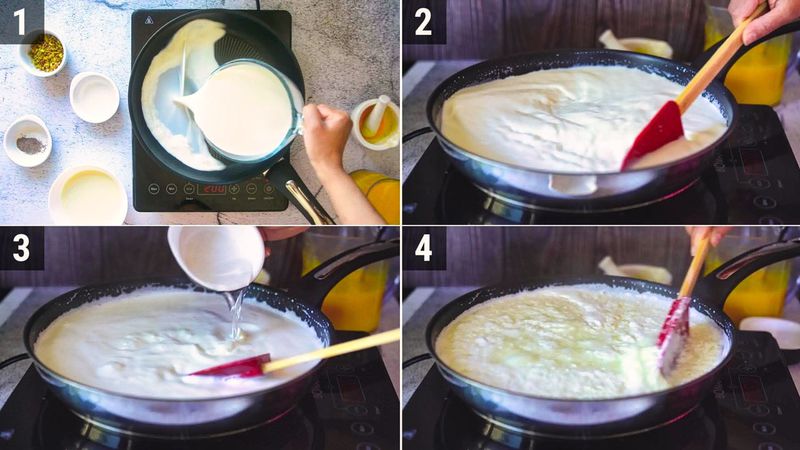
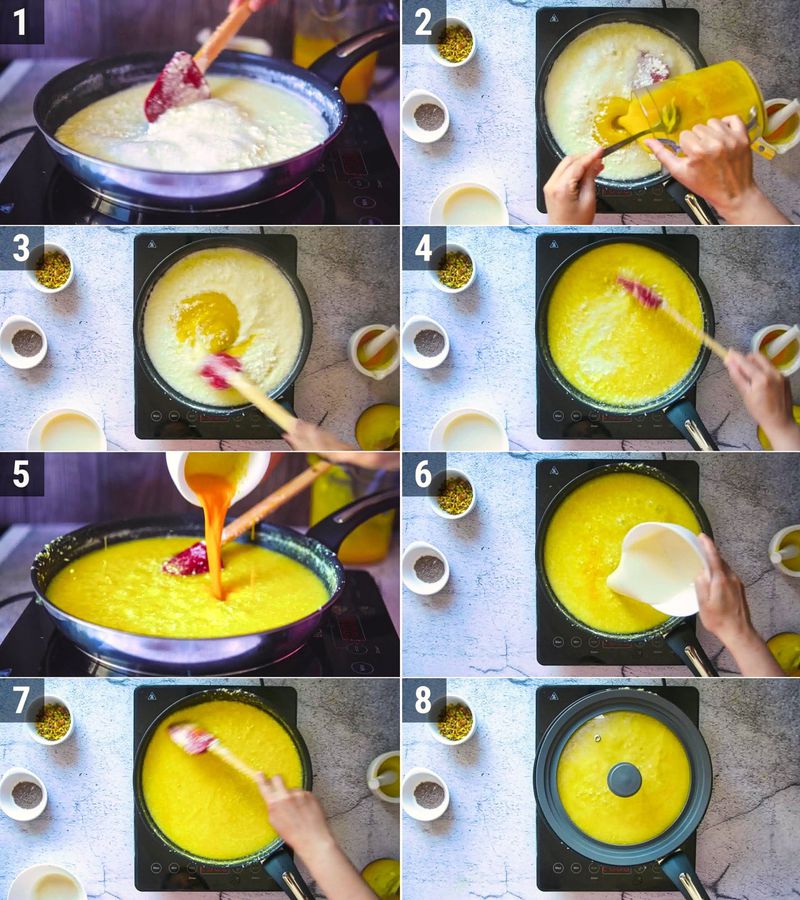
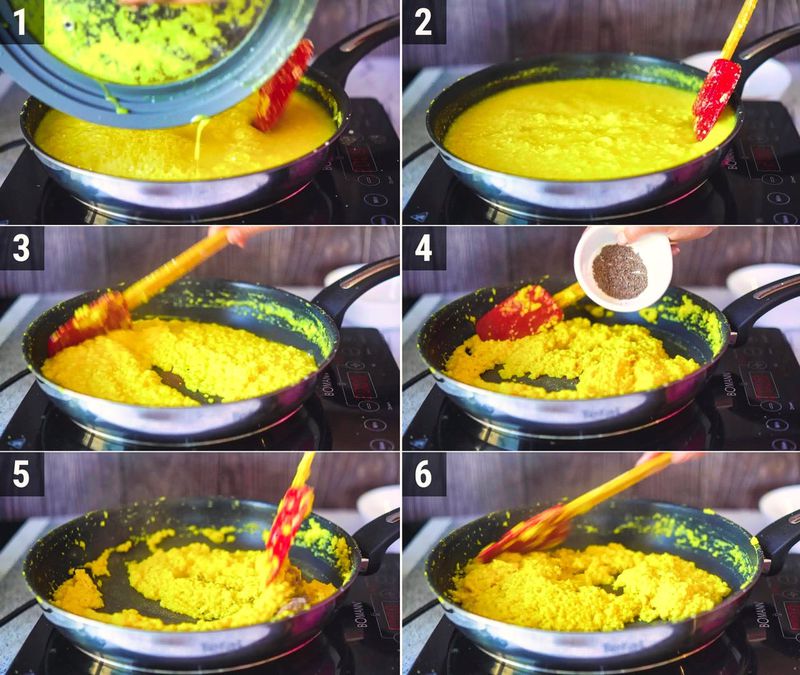
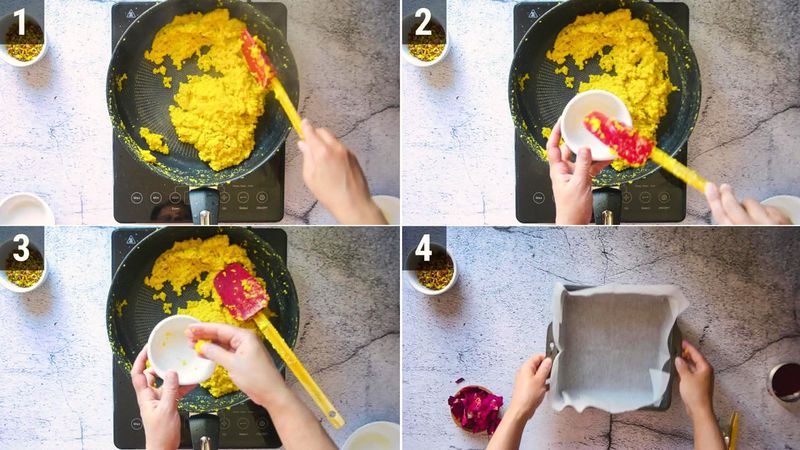
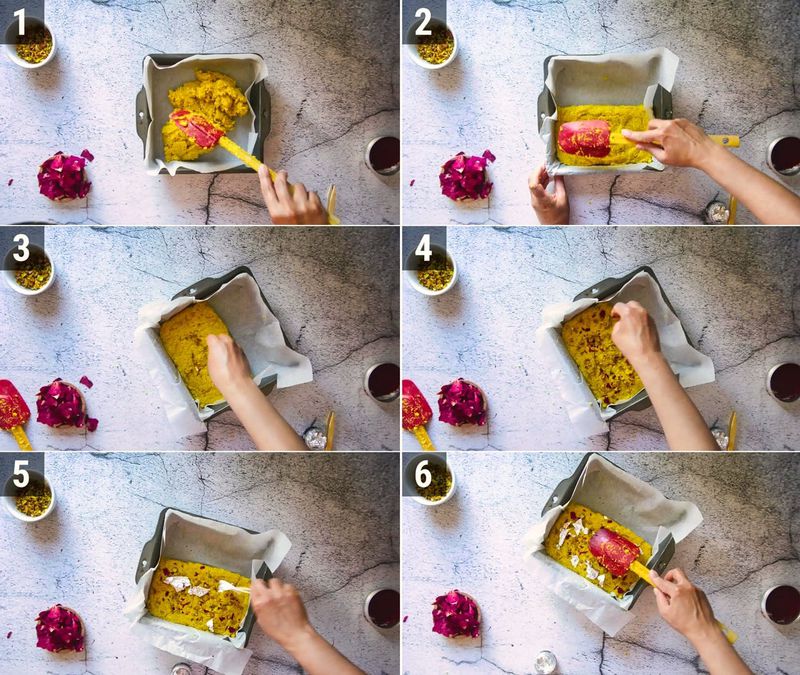

Recipe Card
Mango Kalakand [Recipe]
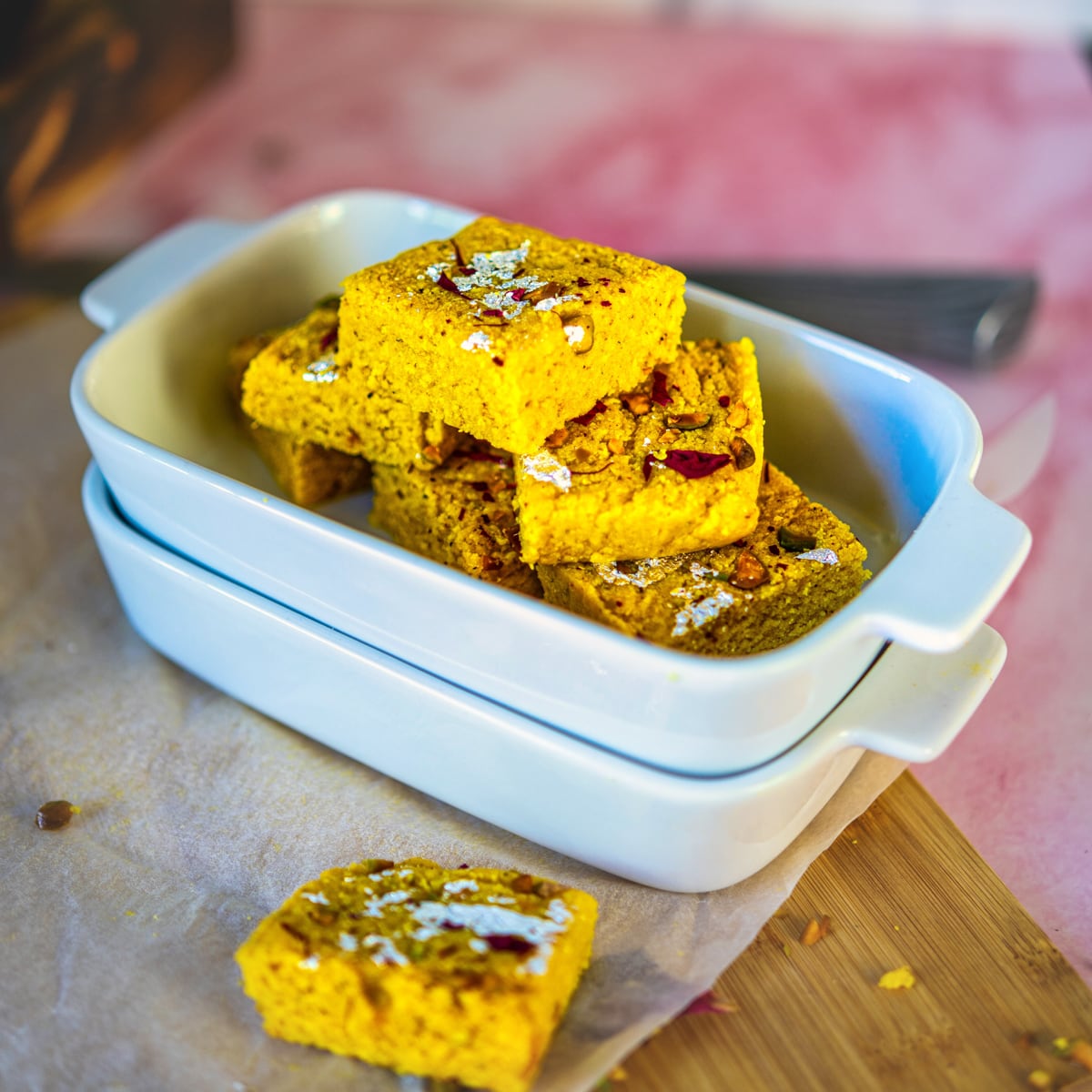
★★★★★
(Rating: 5 from 6 reviews)
| Prep time 🕐 | Cook time 🕐 | Total time 🕐 |
|---|---|---|
| 45 mins | ||
| Category ☶ | Cuisine ♨ | Serves ☺ |
| Desserts | Indian | 8-10 |
| Nutrition Info ⊛ | Serving size ⊚ | |
| 144 calories | 1 |
INGREDIENTS
For Mango Kalakand
- 2 liters of full-cream (whole) milk
- 2 tablespoons of white vinegar
- 1 1/4 cups of fresh mango puree or mango pulp
- 8-10 saffron strands soaked in 2 tablespoons warm milk
- 1/2 teaspoon of optional cardamom powder
- 1 cup of sweetened condensed milk, adjust to taste
- 1-2 tablespoons of chopped pistachios for garnish (optional)
- 7-8 saffron strands for garnish (optional)
- 5-6 crushed dried rose petals for garnish (optional)
- Edible sliver/golden leaves for garnish (optional)
INSTRUCTIONS:
For making Mango Kalakand
- In a thick-bottomed pan, pour 2 liters of full-cream milk over medium heat. Allow it to come to a boil while stirring constantly to prevent sticking. This should take around 10 minutes. Once the milk is boiling, add23 tablespoons of white vinegar and stir thoroughly. You'll notice the milk curdling, and it will separate into curds and whey. If the curdling is insufficient, even after adding vinegar, it indicates that more vinegar is needed. In such a case, add another tablespoon of vinegar.
- Increase the heat to medium-high and continue boiling the mixture until it reduces by half, stirring occasionally. After this, incorporate the mango puree and stir again to combine. Add 2 tablespoons of saffron-soaked milk and sweetened condensed milk. Stir well and cook for 2 more minutes. Then, cover the pan with a lid and let it cook for 5-7 minutes, stirring occasionally.
- Remove the lid, stir the mixture thoroughly, and then lower the heat to low-medium. Keep stirring and cooking for 10-12 minutes. As the mixture thickens, it will start to leave the sides of the pan. At this stage, mix in the cardamom powder and cook for an additional 3-4 minutes.
- The kalakand mixture is ready when it forms a non-sticky ball. This process usually takes about 5-6 minutes over low heat. To check the setting consistency, take a small portion of the mixture in your hand and roll it between your fingers. If it's non-sticky and holds its shape, it's ready to set. Grease and line a pan or container with parchment paper.
- Transfer the mango kalakand mixture into the prepared pan and spread it evenly with a spatula. Garnish with chopped pistachios, saffron strands, dried rose petals, and edible silver leaves if desired. Gently press down with the spatula so that the nuts stick to the mango kalakand.
- Allow the kalakand to set for about two hours at room temperature, or for 1 hour in the refrigerator, or 15 minutes in the freezer. Once set, remove the kalakand from the pan and cut it into your desired pieces. Mango kalakand can be stored in the refrigerator for up to 7-8 days.
WATCH RECIPE VIDEO: Click the play button and video will load ...
NOTES:
- Simmering on medium heat, stirring constantly is recommended to prevent it from sticking to the bottom of the pan.
- For a lovely color and profound saffron flavor, it is recommended to soak crushed saffron strands in warm milk for at least 10 minutes before adding to the mixture.
- Using fresh mango puree or pulp ensures the best taste and texture. But if you are making it in the off season then you can make the same recipe with store-bought mango puree.
- When slicing the Kalakand, make sure to use a sharp knife to get the clean cuts.
- You can swap white vinegar with the same amount of lemon juice.
